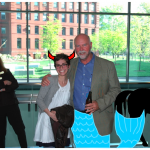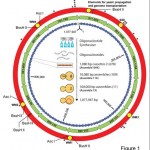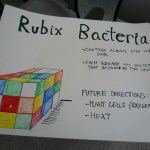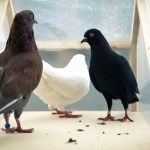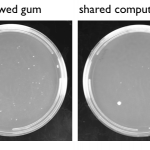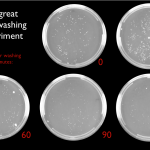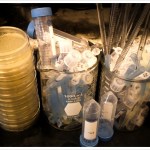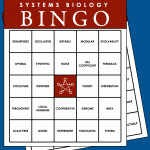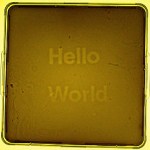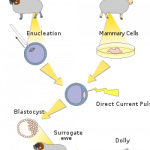
The reaction to the Venter Institute's synthetic genome transplantation has been decidedly mixed. Is this the beginning of something new and wonderful, the ability to really design organisms from scratch? Is it something more sinister, the beginning of a dark era where techno-corporate (or terrorist) interests can design something that will destroy the environment in catastrophic ways? Is it just a technical advance or a conceptual breakthrough? A philosophical revolution? Is it a Big Deal or big whoop? Synthetic biology has never been just one thing and still has many different goals, with a…
This is a pretty old video we made about Craig Venter that I've shared before on Hydrocalypse, but I think now is a good time to share it again. When Craig isn't creating synthetic bacteria, he's sailing the world, searching the oceans for interesting DNA sequences. We were inspired by this lifestyle (and sometimes even his science too) and SNL, and from that came Venter's on a Boat, by Hydrocalypse Industries (warning: the song contains a lot of bad language):
The J. Craig Venter Institute has just announced the creation of the first bacterial cell controlled by a genome that is entirely chemically synthesized (PDF). The group has been working towards this goal for several years now, first working out how to synthesize and assemble such large pieces of DNA and how to transplant a genome from one organism to another. This result puts it all together, a synthetic version of the genome of the bacterium Mycoplasma mycoides and transplantation into a Mycoplasma capricolum cell. This synthetic cell is almost identical to a natural M. mycoides, but also…
I've written before about artificial life researchers from the 18th and 20th centuries working to create robots that attempt to recreate the human voice. I recently saw this terrifying video over at the PopSci blog of a recent robotic voice machine and wanted to share it:
Over at Noise For Airports, Nick shares a very different way to combine biology, computer science, and music--The Heart Chamber Orchestra, which plays music generated from the rhythm of their combined heartbeats in real time:
My silkworms are starting to turn into silkmoths! The first moth emerged from his cocoon this weekend, I hope more are close behind so that he can mate before he dies! I didn't expect him to come out so soon so I didn't have my real camera but I wanted to share my blurry phone pictures of the event:
In industrial silk production they can't use the cocoon that gets left behind because the moth uses an enzyme called cocoonase to chew his way out, breaking the otherwise continuous silk thread. I'm starting to explore ways that I can use this silk though--so far I've only made friendship…
Are aliens little green men of unpredictable motives? Horrible insect-like face-hugging, chest-exploding monsters? Are they super-smart, super-slimy, super-fishy, body-cavity-probing, disc-flying creatures, searching for planets to colonize and people to destroy as Stephen Hawking warned, or are they something much more mundane? Could there be alien life already on earth, too microscopic, too different to notice? Could life on earth have been seeded from an alien land, with secret messages encoded in our DNA? We've been scanning the sky for extraterrestrial radio signals for years, should we…
I've been co-teaching a short class on synthetic biology this spring through the MIT High School Studies Program (HSSP). The program is awesome, I took classes through a similar MIT program as a nerdy middle schooler and have had a great time teaching the past few weeks (if you're in the Boston area I highly recommend checking it out as a student or as a volunteer teacher!). My students were terrific--smart, open to new and crazy ideas, thoughtful about bioethics issues, and enthusiastic about thinking about what biology can do and designing new biological species.
Today was our last day of…
Unlike many of my colleagues, I'm not really interested in the whole "science vs. religion" thing, but I do want to point out the very thoughtful analysis of genetic engineering and synthetic biology by the Church of Scotland's Society, Religion, and Technology Project. On GM food, they write:
The official scientific and economic reports support the view of the 1999 Assembly, that GM is not a simple 'yes or no' issue and must be taken case-by-case, weighing up many different factors. Theologically, SRT has found no convincing reason to say it is a wrong act to transfer genes into a crop from…
I'm a little late in posting about the recent work of Tuur Van Balen, a Belgian designer who uses art and design to explore the boundaries between people and technology. His work has explored synthetic biology and biotechnology for years, and I first was introduced to his work through news of his Urban Biogeography project. A recent focus in synthetic biology has been the design of simple biosensors, strains of bacteria or yeast that can sense an environmental pollutant and produce a measurable output such as color change. Thanks to the work of several very creative iGEM teams, the Registry…
The past few days I've been learning a lot about the bacteria that surround me and realizing just how labor intensive an actually well-controlled handwashing experiment can be! Here is a little bit more of the data I've collected about bacteria on everyday objects:
Dusty corners (unsurprisingly?) have the most bacteria, followed by chewed gum, then pens and computer mice. These data also show that the medium of bacterial transmission has a huge effect on what shows up on the plate. Leaving the actual object on the plate--in this case a dust bunny--allows for a lot of bacterial transfer, as…
I've been busily rubbing all sorts of things on bacterial growth plates after all the great suggestions I got yesterday. I want to present the data from the first big experiment suggested by JerryM, who wondered what kind of bacteria would be present on my hands immediately after washing them and then every thirty minutes after that until the next washing. My hypothesis was that there would be a small number of colonies on the plate I touched right after washing, and then steadily growing in number over time. I thought this would especially be true considering that I spend most of my time…
Commenter JohnV asked me whether I had let any of my silkworms crawl on an LB plate (what microbiologists use to grow colonies of bacteria) to see what kind of bacteria is living on them in case I ever suffer from catastrophic experiment contamination. I hadn't thought of what kind of bacteria could be living on my silkworms (we are thinking about what kind of bacteria live in their digestive systems that help them digest leaves) so I tried it out! I let one of my wormies crawl on a plate, and I touched one with my relatively clean fingers as a pseudo-control.
I let the plates incubate at 37…
My semester in MIT's course on Documenting Science Through Video and New Media has drawn to a close. I've had a wonderful time and learned a lot about how films and science are constructed by different people in different times for different reasons. Most of all I've learned about how challenging it can be to put together an interesting narrative and present a point of view while at the same time ensuring that the science being explained is honest and clear to everyone. I've recently gotten the chance to watch two great recent science documentaries outside of class, Naturally Obsessed and…
So I had this great post planned about the Boston aquapocalypse but by the time I managed to get some water samples to the lab they had started heavily chlorinating the water and no bacteria were left! Since negative results don't make for good blog posts, please enjoy this video of my silkworms dancing to Flo Rida's Right Round instead.
I got the chance to attend a panel discussion about science and the media presented by the UK-based charity Sense About Science. The audience was primarily scientists, many of whom were angry about how science is presented in the media: the outlandish claims, the hype, presenting "both sides" of stories where there is clear scientific consensus. The panel included a professional scientist who teaches about communicating with the public, an editor at the journal Cell, and a science reporter for the Boston Globe.
The panel was mostly about "traditional" media, with a little shout-out to blogs…
Silks are incredible protein fibers produced by many different species of insects. Besides their use in making versatile textiles, silks are currently used in many different medical and engineering applications, from sutures to tissue engineering scaffolds to flexible electrode brain implants. Since I love fabrics and I'm interested in what biological engineers can do with biomaterials, I recently started working on a fun side project to raise and engineer silkworms, the animals used in industrial silk production around the world. We're having a lot of fun learning about silk and how to raise…
Many people in synthetic biology, including myself and much of my lab, are working on using biology to make things more efficiently, renewably, and sustainably. Being able to make plastic replacing biomaterials, chemicals, medicines, and fuels in living cells from renewable resources (especially in photosynthetic organisms that need only sunlight and water) will undoubtedly decrease our dependence on fossil fuels and with a lot of work in policy and process and infrastructure engineering may one day become truly sustainable. It's difficult to not notice, however, how unsustainable most…
Light interacts with and controls biological systems in diverse and fascinating ways. Our eyes are made up of thousands of cells that respond to light, sending signals to our brain as light in different colors and shapes moves across them. Photosynthetic cells are full of receptors that can sense and respond to many wavelengths of light, allowing cells to absorb light for photosynthesis, but also to move towards areas of more sunlight and know when the seasons are changing. Synthetic biology takes these light-responsive systems as parts that can be recombined, shuffled and integrated into…
New in vitro fertilization technology is making it possible for someone to have two moms--one that provides the genome in the nucleus of the cell, and one that provides the rest of the egg cell, including the mitochondria. Since all mitochondria are passed down from the mother in the egg (sperm are just too small to provide anything but the father's genetic material to the fertilized embryo), transplanting the nucleus from a fertilized embryo to an egg from a different woman can bypass the transmission of any mitochondrial diseases that the mother carries. Because mitochondria have their own…
